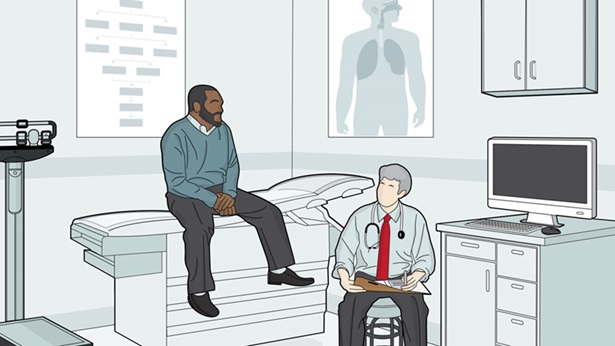Antibiotic Use in Outpatient Settings
Health experts create national targets to reduce unnecessary antibiotic prescriptions

Overview
The use and misuse of antibiotics is a major contributor to the development of antibiotic-resistant bacteria. These drugs should be used only to treat bacterial infections and, when needed, the right antibiotic should be prescribed at the most appropriate dose and duration. Yet antibiotics are often prescribed inappropriately across health care settings in the United States. Antibiotic stewardship efforts, which aim to ensure that these drugs are prescribed appropriately, are critical for combating the public health threat posed by antibiotic-resistant pathogens. To effectively implement and evaluate stewardship efforts, it is essential to first understand current antibiotic prescribing patterns.
Antibiotic use in outpatient health care settings, such as primary care offices and emergency rooms, represents the majority of dollars spent on antibiotics for human health care in the United States.1 Beginning in 2015, The Pew Charitable Trusts convened a panel of experts, including representatives from the Centers for Disease Control and Prevention (CDC) and other public health and medical experts to analyze current outpatient antibiotic prescribing habits in the United States, determine targets for reducing inappropriate prescribing, and identify steps needed to reach these targets.
Key findings from this analysis are:
- Antibiotics should be prescribed only when a bacterial infection is known or suspected. Approximately 13 percent of all outpatient office visits in the United States, or about 154 million visits annually, result in an antibiotic prescription; about 30 percent of these, or some 47 million prescriptions, are unnecessary.
- 44 percent of outpatient antibiotic prescriptions are written to treat patients with acute respiratory conditions, such as sinus infections, middle ear infections, pharyngitis, viral upper respiratory infections (i.e., the “common cold”), bronchitis, bronchiolitis, asthma, allergies, influenza, and pneumonia. Half of these prescriptions are unnecessary, since many are viral illnesses or other conditions that do not respond to antibiotics.
- In 2015, the White House released a national action plan for combating antibiotic resistance that included the goal of reducing inappropriate outpatient antibiotic use by 50 percent by 2020.2 Based on the panel’s estimate of unnecessary prescribing, this goal would be reached by reducing outpatient antibiotic use by 15 percent overall, which would result in approximately 23 million fewer antibiotics prescribed annually by 2020.
This report is the first in a series evaluating current antibiotic use in the United States and establishing national targets for improved prescribing practices in different health care settings.
This report is the first in a series evaluating current antibiotic use in the United States and establishing national targets for improved prescribing practices in different health care settings.
In addition to these findings, the expert panel discussed the importance of increased stewardship activities to ensure that the United States reaches the goal laid out in the 2015 national action plan. There is no one-size-fits-all stewardship program that practitioners can implement in their facilities. However, a number of interventions have been shown to be effective at improving prescribing habits, such as providing clinicians with individualized antibiotic prescribing feedback.
Since no single agency or organization oversees antibiotic use in outpatient facilities across the country, implementing stewardship programs nationwide will be a complex undertaking. A diverse group of stakeholders will need to take coordinated and sustained action to provide the resources and expertise necessary to expand stewardship efforts. Below is a sampling of roles that stakeholders could play in reducing inappropriate outpatient antibiotic use:
- Individual outpatient health care providers can evaluate their own prescribing habits as well as implement stewardship activities in their practices.
- Health systems can provide expertise and resources to offices within their network to aid in stewardship implementation.
- Health plans can assist in data collection and analysis—evaluating the antibiotic prescribing habits of their providers and providing feedback highlighting potential areas for improvement.
- State and local health agencies can help provide outpatient facilities with information on best practices for implementing antibiotic stewardship programs, and help develop regional partnerships between various health care stakeholders, such as providers, health plans, and health systems, to better coordinate stewardship activities.
- Federal agencies can track antibiotic prescribing at the national level, identifying areas for further improvement and providing technical assistance to stakeholders interested in implementing stewardship efforts of their own.
- Organizations that develop standards to assess the quality of health care services can develop metrics to assess the antibiotic prescribing habits of health care providers.
- Health care professional societies can provide expert guidance to their members on appropriate antibiotic prescribing and incorporating diagnostics to aid in prescribing decision-making.
BACKGROUND
Antibiotics are essential to the practice of modern medicine—from treating common infections to enabling lifesaving procedures such as organ transplantation. However, the emergence and spread of antibiotic-resistant bacteria threaten the effectiveness of these critical therapies. According to the World Health Organization, high rates of resistance in common bacteria are being seen worldwide.3 In the United States, drug-resistant bacteria are responsible for at least 2 million infections each year, resulting in an estimated 23,000 deaths.4
Infections caused by multidrug-resistant bacteria are becoming increasingly common. A 2011 survey of U.S. infectious disease physicians found that over 60 percent of respondents had treated a patient with an infection resistant to all available antibiotics.5 Of particular concern is the spread of carbapenem-resistant Enterobacteriaceae (CRE), due to its resistance to many, if not all, available therapies and its high mortality rate once infecting the bloodstream.6 In 2001, only one state reported a case of CRE; as of early 2015, only two states had not reported one.7
Importance of improved antibiotic stewardship
All antibiotic use, whether appropriate or not, carries a risk of contributing to the development of antibiotic resistance. To minimize this threat and preserve the effectiveness of these important drugs, antibiotics should be used judiciously and prescribed only when recommended. However, much antibiotic use is unnecessary or inappropriate.8 Over 60 percent of antibiotic expenditures in the United States occur in outpatient settings where patients are seen for many conditions that do not warrant antibiotic use, such as acute bronchitis.9 Antibiotic stewardship efforts aim to ensure that these drugs are used only when indicated (i.e., for a known or suspected bacterial infection) and prescribed at the right dose and duration of therapy. Such programs are critical to limiting the development of antibiotic resistance.
In addition to the importance of antibiotic stewardship in minimizing the threat of resistance, reducing inappropriate antibiotic use can also improve patient safety. Exposure to antibiotics increases a patient’s risk of an infection caused by Clostridium difficile, which can cause sometimes life-threatening diarrhea. There were nearly 500,000 estimated cases of C. difficile infection in the United States in 2011, which resulted in approximately 15,000 deaths.10 Antibiotics also carry the risk of adverse drug events, including drug interactions, allergic reactions ranging from minor rashes to life-threatening responses, and other side effects. It is estimated that antibiotic-related adverse events result in more than 140,000 emergency room visits a year.11
ENDNOTES
- Katie J. Suda et al., “A National Evaluation of Antibiotic Expenditures by Healthcare Setting in the United States, 2009,” Journal of Antimicrobial Chemotherapy 68, no. 3 (2013): 715–718, doi:10.1093/jac/dks445, http://jac.oxfordjournals.org/content/68/3/715.
- The White House, National Action Plan for Combating Antibiotic-Resistant Bacteria, March 2015, accessed July 27, 2015, https://www.whitehouse.gov/sites/default/files/docs/national_action_plan_for_combating_antibotic-resistant_bacteria.pdf.
- World Health Organization, Antimicrobial Resistance: Global Report on Surveillance, 2014, accessed July 28, 2015, http://apps.who.int/iris/ bitstream/10665/112642/1/9789241564748_eng.pdf?ua=1.
- U.S. Centers for Disease Control and Prevention, Antibiotic Resistance Threats in the United States, 2013, accessed Nov. 12, 2014, http:// www.cdc.gov/drugresistance/threat-report-2013.
- Adam L. Hersh et al., “Unmet Medical Need in Infectious Diseases,” Clinical Infectious Diseases 54, no. 11 (2012): 1677–1678, doi: 10.1093/ cid/cis275, http://www.ncbi.nlm.nih.gov/pmc/articles/PMC3404719.
- U.S. Centers for Disease Control and Prevention, Antibiotic Resistance Threats.
- U.S. Centers for Disease Control and Prevention, “CDC’s Graphs of the Year: Nightmare Bacteria Spread and 100,000 Smokers Likely Quit With Tips,” accessed July 28, 2015, http://www.cdc.gov/media/releases/2013/a1231-graphs-year.html; U.S. Centers for Disease Control and Prevention, “Tracking CRE Infections,” accessed July 28, 2015, http://www.cdc.gov/hai/organisms/cre/TrackingCRE.html.
- U.S. Centers for Disease Control and Prevention, Antibiotic Resistance Threats.
- Suda et al., “A National Evaluation of Antibiotic Expenditures,” 715–718.
- Fernanda C. Lessa et al., “Burden of Clostridium difficile Infection in the United States,” New England Journal of Medicine 372, no. 9 (2015): 825–834, doi: 10.1056/NEJMoa1408913, http://www.nejm.org/doi/full/10.1056/NEJMoa1408913#t=article.
- Nadine Shehab et al., “Emergency Department Visits for Antibiotic-Associated Adverse Events,” Clinical Infectious Diseases 47, no. 6 (2008): 735–743, doi: 10.1086/591126, http://cid.oxfordjournals.org/content/47/6/735.long.
- U.S. Centers for Disease Control and Prevention, Antibiotic Resistance Threats.
- Anthony W. Chow et al., “IDSA Clinical Practice Guideline for Acute Bacterial Rhinosinusitis in Children and Adults,” Clinical Infectious Diseases 54, no. 8 (2012): e72–e112, doi: 10.1093/cid/cir1043, http://cid.oxfordjournals.org/content/early/2012/03/20/cid.cir1043. full; Richard M. Rosenfeld et al., “Clinical Practice Guideline (Update): Adult Sinusitis,” Otolaryngology-Head & Neck Surgery 152, suppl. 2 (2015): S1–S39, doi: 10.1177/0194599815572097, http://oto.sagepub.com/content/152/2_suppl/S1.long; Ellen R. Wald et al., “Clinical Practice Guideline for the Diagnosis and Management of Acute Bacterial Sinusitis in Children Aged 1 to 18 Years,” Pediatrics 132 (2013): e262–e280, doi: 10.1542/peds.2013-1071, http://pediatrics.aappublications.org/content/early/2013/06/19/peds.2013-1071.
- George H. Talbot et al., “Rigid Nasal Endoscopy versus Sinus Puncture and Aspiration for Microbiologic Documentation of Acute Bacterial Maxillary Sinusitis, Clinical Infectious Diseases 33, no. 10 (2001): 1668–1675, doi: 10.1086/323813, http://cid.oxfordjournals.org/content/33/10/1668.full.pdf+html.
- Chow et al., “IDSA Clinical Practice Guideline.”
- American Academy of Family Physicians, American Academy of Otolaryngology-Head and Neck Surgery, and American Academy of Pediatrics Subcommittee on Otitis Media With Effusion, “Otitis Media With Effusion,” Pediatrics 113, no. 5 (2004): 1412–1429, http://pediatrics.aappublications.org/content/113/5/1412.
- Allan S. Lieberthal et al., “The Diagnosis and Management of Acute Otitis Media,” Pediatrics 131, no. 3 (2013): e964-e999, doi: 10.1542/ peds.2012-3488, http://pediatrics.aappublications.org/content/early/2013/02/20/peds.2012-3488.
- No reduction target was set for adults 65 and older as there were not enough suppurative middle ear infection visits resulting in antibiotic prescriptions to make a reliable estimate.
- Stanford T. Shulman et al., “Clinical Practice Guideline for the Diagnosis and Management of Group A Streptococcal Pharyngitis: 2012 Update by the Infectious Diseases Society of America,” Clinical Infectious Diseases 55, no. 10 (2012): e86–e102, doi: 10.1093/cid/cis629, http://cid.oxfordjournals.org/content/55/10/e86.
- Ibid.
- Nader Shaikh, Erica Leonard, and Judith M. Martin, “Prevalence of Streptococcal Pharyngitis and Streptococcal Carriage in Children: A Meta-Analysis,” Pediatrics 126, no. 3 (2010): e557–e564, doi: 10.1542/peds.2009-2648; Andrew M. Fine, Victor Nizet, and Kenneth D. Mandl, “Large-Scale Validation of the Centor and McIsaac Scores to Predict Group A Streptococcal Pharyngitis,” Archives of Internal Medicine 172, no. 11 (2012): 847–852, doi: 10.1001/archinternmed.2012.950, http://archinte.jamanetwork.com/article. aspx?articleid=1157417.
- No reduction target was set for adults 65 and older as there were not enough pharyngitis visits resulting in antibiotic prescriptions to make a reliable estimate.
- Mayo Clinic, “Diseases and Conditions—Common Cold: Symptoms,” accessed Jan. 25, 2016, http://www.mayoclinic.org/diseases- conditions/common-cold/basics/symptoms/con-20019062.
- Adam L. Hersh et al., “Principles of Judicious Antibiotic Prescribing for Upper Respiratory Tract Infections in Pediatrics,” Pediatrics 132, no. 6 (2013): 1146–1154, doi: 10.1542/peds.2013-3260, http://pediatrics.aappublications.org/content/132/6/1146; Vincenza Snow et al., “Principles of Appropriate Antibiotic Use for Treatment of Nonspecific Upper Respiratory Tract Infections in Adults,” Annals of Internal Medicine 134, no. 6 (2001): 487–489, doi: 10.7326/0003-4819-134-6-200103200-00014; Scott F. Dowell et al., “Appropriate Use of Antibiotics for URIs in Children: Part II, Cough, Pharyngitis and the Common Cold,” American Family Physician 58, no. 6 (1998): 1335–1342, http://www.aafp.org/afp/1998/1015/p1335.html.
- Shawn L. Ralston et al., “Clinical Practice Guideline: The Diagnosis, Management, and Prevention of Bronchiolitis,” Pediatrics 134, no. 5 (2014): e1474-e1502, doi: 10.1542/peds.2014-2742, http://pediatrics.aappublications.org/content/134/5/e1474.
- Ralston et al., “Clinical Practice Guideline”; Vincenza Snow et al., “Principles of Appropriate Antibiotic Use for Treatment of Acute Bronchitis in Adults,” Annals of Internal Medicine 134, no. 6 (2001): 518-520, doi: 10.7326/0003-4819-134-6-200103200-00020.
- Mayo Clinic, “Diseases and Conditions—Allergies: Symptoms,” accessed Jan. 25, 2016, http://www.mayoclinic.org/diseases-conditions/ allergies/basics/symptoms/con-20034030; Mayo Clinic, “Diseases and Conditions—Asthma: Symptoms,” accessed Jan. 25, 2016, http://www.mayoclinic.org/diseases-conditions/asthma/basics/symptoms/con-20026992.
- National Heart, Lung, and Blood Institute, National Asthma Education and Prevention Program, Expert Panel Report 3: Guidelines for the Diagnosis and Management of Asthma (2007), accessed Sept. 14, 2015, http://www.nhlbi.nih.gov/files/docs/guidelines/asthgdln.pdf.
- Mosby’s Medical Dictionary, 9th ed., s.v. “influenza.”
- Anthony E. Fiore et al., “Antiviral Agents for the Treatment and Chemoprophylaxis of Influenza: Recommendations of the Advisory Committee on Immunization Practices (ACIP),” Morbidity and Mortality Weekly Report 60, no. 1 (2011): 1–25, http://www.cdc.gov/mmwr/ pdf/rr/rr6001.pdf.
- Mayo Clinic, “Diseases and Conditions—Pneumonia: Symptoms,” accessed Jan. 25, 2016, http://www.mayoclinic.org/diseases- conditions/pneumonia/basics/symptoms/con-20020032.
- John S. Bradley et al., “Executive Summary: The Management of Community-Acquired Pneumonia in Infants and Children Older than 3 Months of Age: Clinical Practice Guidelines by the Pediatric Infectious Diseases Society and the Infectious Diseases Society of America,” Clinical Infectious Diseases 53, no. 7 (2011): 617–630, doi: 10.1093/cid/cir625, http://cid.oxfordjournals.org/content/53/7/617.full; Lionel A. Mandell et al., “Infectious Diseases Society of America/American Thoracic Society Consensus Guidelines on the Management of Community-Acquired Pneumonia in Adults,” Clinical Infectious Diseases 44, suppl. 2 (2007): S27–S72, doi: 10.1086/511159, http://cid.oxfordjournals.org/content/44/Supplement_2/S27.full.
- Kalpana Gupta et al., “International Clinical Practice Guidelines for the Treatment of Acute Uncomplicated Cystitis and Pyelonephritis in Women: A 2010 Update by the Infectious Diseases Society of America and the European Society for Microbiology and Infectious Diseases,” Clinical Infectious Diseases 52, no. 5 (2011): e103–e120, doi: 10.1093/cid/ciq257, http://cid.oxfordjournals.org/content/52/5/ e103.full; American Academy of Pediatrics, Subcommittee on Urinary Tract Infection, Steering Committee on Quality Improvement and Management, “Urinary Tract Infection: Clinical Practice Guideline for the Diagnosis and Management of the Initial UTI in Febrile Infants and Children 2 to 24 Months,” Pediatrics 128, no. 3 (2011): 595–610, doi: 10.1542/peds.2011-1330, http://pediatrics.aappublications.org/ content/128/3/595.
- Jeffrey S. Gerber et al., “Effect of an Outpatient Antimicrobial Stewardship Intervention on Broad-Spectrum Antibiotic Prescribing by Primary Care Pediatricians: A Randomized Trial,” Journal of American Medical Association 309, no. 22 (2013): 2345–2352, doi: 10.1001/ jama.2013.6287, http://jama.jamanetwork.com/article.aspx?articleid=1696098.
- Dimitri Drekonja et al., Antimicrobial Stewardship Programs in Outpatient Settings: A Systematic Review, U.S. Department of Veterans Affairs, Health Services Research and Development Service, Evidence-based Synthesis Program (2014), accessed Aug. 21, 2015, http://www.ncbi.nlm.nih.gov/pubmedhealth/PMH0072334/pdf/PubMedHealth_PMH0072334.pdf.
- Ralph Gonzales et al., “A Cluster Randomized Trial of Decision Support Strategies for Reducing Antibiotic Use in Acute Bronchitis,” Journal of the American Medical Association Internal Medicine 173, no. 4 (2013): 267–273, doi: 10.1001/jamainternmed.2013.1589, http://archinte. jamanetwork.com/article.aspx?articleid=1556795; Thomas G. McGinn et al., “Efficacy of an Evidence-Based Clinical Decision Support in Primary Care Practices: A Randomized Clinical Trial,” Journal of the American Medical Association Internal Medicine 173, no. 17 (2013): 1584–1591, doi: 10.1001/jamainternmed.2013.8980, http://archinte.jamanetwork.com/article.aspx?articleid=1722509.
- Guillermo V. Sanchez et al., “Effects of Knowledge, Attitudes, and Practices of Primary Care Providers on Antibiotic Selection, United States,” Emerging Infectious Diseases 20, no. 12 (2014): 2041–2047, doi: 10.3201/eid2012.140331, http://wwwnc.cdc.gov/ eid/article/20/12/14-0331_article; Patrick P. Dempsey et al., “Primary Care Clinicians’ Perceptions About Antibiotic Prescribing for Acute Bronchitis: A Qualitative Study,” BMC Family Practice 15, no. 194 (2014), doi: 10.1186/s12875-014-0194-5, http://bmcfampract. biomedcentral.com/articles/10.1186/s12875-014-0194-5.
- Rita Mangione-Smith et al., “Communication Practices and Antibiotic Use for Acute Respiratory Tract Infections in Children,” Annals of Family Medicine 13, no. 3 (2015): 221–227, doi: 10.1370/afm.1785, http://www.annfammed.org/content/13/3/221.full.
- National Committee for Quality Assurance, “HEDIS 2016 Volume 2: Technical Specifications for Health Plans” (2015), http://www.ncqa.org/HEDISQualityMeasurement/HEDISMeasures/HEDIS2016.aspx.
- Mosby’s Medical Dictionary, 9th ed., s.v. “allergy.”
- Taber’s Cyclopedic Medical Dictionary, 22nd ed., s.v. “asthma.”
- Ralston et al., “Clinical Practice Guideline.”
- Mosby’s Medical Dictionary, 9th ed., s.v. “bronchitis.”
- Mosby’s Medical Dictionary, 9th ed., s.v. “influenza.”
- Mosby’s Medical Dictionary, 9th ed., s.v. “otitis media”; D. Stewart Rowe, “Acute Suppurative Otitis Media,” Pediatrics 56, no. 2 (1975): 285-294, http://pediatrics.aapublications.org/content/56/2/285.short; American Academy of Family Physicians, “Otitis Media With Effusion,” 1412–1429.
- Mosby’s Medical Dictionary, 9th ed., s.v. “pharyngitis.”
- Mosby’s Medical Dictionary, 9th ed., s.v. “pneumonia.”
- Chow, “IDSA Clinical Practice Guidelines.”
- Mosby’s Medical Dictionary, 9th ed., s.v. “upper respiratory infection.”
- Taber’s Cyclopedic Medical Dictionary, 22nd ed., s.v. “urinary tract infection.”
- U.S. Centers for Disease Control and Prevention, “Outpatient Antibiotic Prescriptions—United States, 2013,” accessed Nov. 19, 2015, http://www.cdc.gov/getsmart/community/pdfs/annual-reportsummary_2013.pdf.


America’s Overdose Crisis
Sign up for our five-email course explaining the overdose crisis in America, the state of treatment access, and ways to improve care
Sign up

Pew, CDC Release National Targets for Reducing Unnecessary Antibiotic Use
New report examines the state of outpatient antibiotic prescribing in the U.S., and how it can be improved


National Goals for Reducing Inappropriate Antibiotic Use in Outpatient Settings












